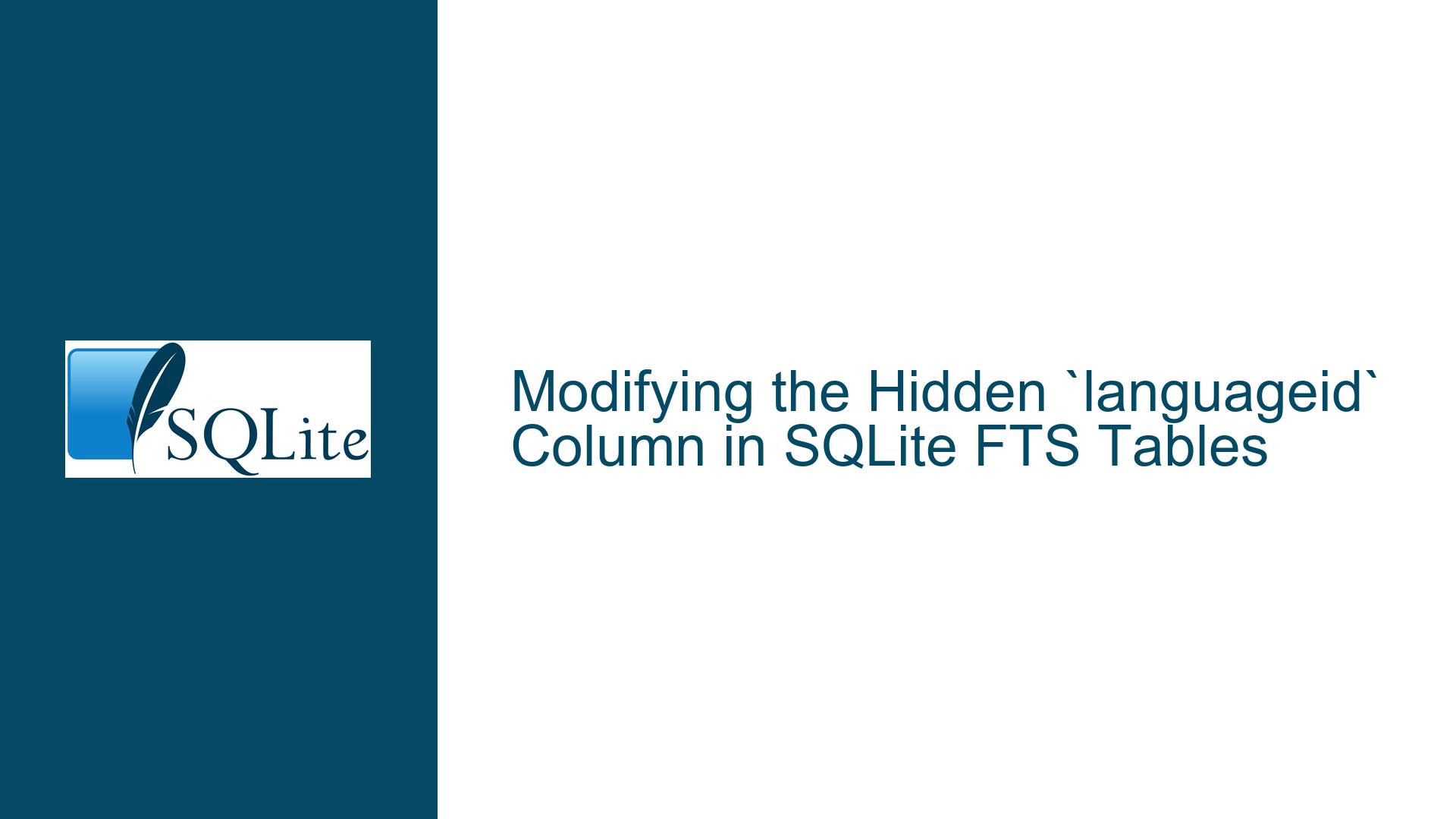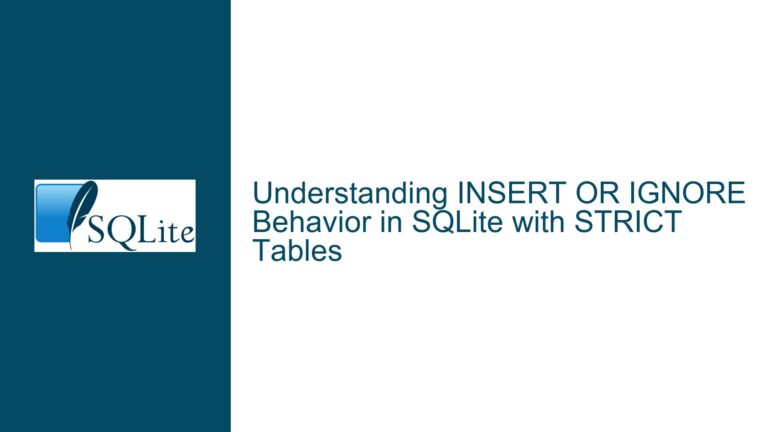Modifying the Hidden `languageid` Column in SQLite FTS Tables
Understanding the languageid Column in FTS Tables
Full-Text Search (FTS) tables in SQLite, specifically FTS3 and FTS4, provide a powerful mechanism for performing efficient text searches across large datasets. One of the lesser-known features of FTS tables is the ability to include a hidden languageid column. This column is designed to store a language identifier for each row, which can be used to tailor the text search behavior based on the language of the content. For instance, the languageid column can influence how stemming or tokenization is applied during searches, making it a valuable tool for multilingual applications.
The languageid column is unique in that it is not directly visible when you describe the table schema using standard SQL commands like .schema or PRAGMA table_info. This hidden nature can lead to confusion, especially when attempting to insert or update values in this column. The column is created implicitly when the FTS table is defined with the languageid option, and its presence is only apparent when you explicitly reference it in your SQL queries.
The primary challenge arises when users attempt to set or modify the value of the languageid column. Since the column is hidden, traditional INSERT or UPDATE statements that do not explicitly reference the column will fail to modify its value. This behavior is by design, as the languageid column is intended to be managed in a specific way to ensure that it functions correctly within the FTS framework.
Common Missteps When Working with the languageid Column
One of the most frequent issues encountered when working with the languageid column is the assumption that it can be treated like any other column in the table. This assumption leads to attempts to insert or update data without explicitly referencing the languageid column, resulting in errors or unexpected behavior. For example, a user might try to insert a row into an FTS table using a standard INSERT statement like INSERT INTO texts (text) VALUES (?), only to find that the languageid column remains unset or defaults to an unexpected value.
Another common mistake is the failure to recognize that the languageid column must be explicitly named in the INSERT or UPDATE statement. This requirement is not immediately obvious, especially to those who are new to working with FTS tables. The hidden nature of the column means that it does not appear in the list of columns when using commands like .schema, leading users to believe that it does not exist or cannot be modified.
Additionally, there is often confusion about the data type and acceptable values for the languageid column. While the column is typically used to store integer values representing language identifiers, the exact range and meaning of these values are not well-documented. This lack of clarity can lead to errors when attempting to set the languageid column to a value that is outside the expected range or of an incorrect data type.
Correctly Setting and Modifying the languageid Column
To successfully set or modify the value of the languageid column in an FTS table, you must explicitly reference the column in your INSERT or UPDATE statements. This approach ensures that the value is correctly assigned to the languageid column, even though it is hidden from the standard table schema.
For example, consider an FTS table named texts with a languageid column named lid. To insert a new row into this table and set the languageid column to a specific value, you would use an INSERT statement like the following:
INSERT INTO texts (text, lid) VALUES (?, ?);
In this statement, the text column is explicitly named, and the lid column (which represents the languageid) is also explicitly referenced. The placeholders ? are used to indicate where the actual values should be inserted, allowing you to safely pass in the text and language identifier as parameters.
Similarly, if you need to update the languageid column for an existing row, you would use an UPDATE statement that explicitly references the languageid column:
UPDATE texts SET lid = ? WHERE rowid = ?;
In this case, the lid column is set to a new value for the row identified by the rowid. Again, the placeholder ? is used to safely pass in the new language identifier and the row identifier as parameters.
It is important to note that the languageid column must be referenced by its actual name, which is specified when the FTS table is created. If the column is named languageid instead of lid, you would need to use that name in your SQL statements. For example:
INSERT INTO texts (text, languageid) VALUES (?, ?);
UPDATE texts SET languageid = ? WHERE rowid = ?;
By explicitly referencing the languageid column in your SQL statements, you can ensure that the values are correctly assigned and that the column functions as intended within the FTS framework.
Best Practices for Managing the languageid Column
When working with the languageid column in FTS tables, it is important to follow best practices to avoid common pitfalls and ensure that your application functions as expected. One key best practice is to always explicitly reference the languageid column in your INSERT and UPDATE statements. This approach eliminates any ambiguity and ensures that the column is correctly set to the desired value.
Another best practice is to carefully manage the values assigned to the languageid column. Since the column is typically used to store integer values representing language identifiers, it is important to ensure that these values are within the expected range and are consistent with the language handling logic in your application. For example, you might define a set of constants or enumerations in your application code to represent different languages, and use these values when setting the languageid column.
It is also important to document the use of the languageid column in your application code and database schema. This documentation should include information about the purpose of the column, the range of acceptable values, and any specific handling logic that is applied based on the language identifier. By documenting this information, you can help ensure that other developers working on the project understand how to correctly use the languageid column and avoid common mistakes.
Finally, it is a good idea to test your application thoroughly to ensure that the languageid column is functioning as expected. This testing should include scenarios where the languageid column is set to different values, and should verify that the text search behavior is correctly tailored based on the language identifier. By testing your application in this way, you can identify and address any issues related to the languageid column before they impact your users.
Advanced Techniques for Working with the languageid Column
In addition to the basic techniques for setting and modifying the languageid column, there are several advanced techniques that can be used to enhance the functionality of FTS tables in SQLite. One such technique is the use of triggers to automatically set the languageid column based on other data in the table. For example, you might define a trigger that sets the languageid column to a specific value whenever a new row is inserted into the table, based on the content of the text column.
Another advanced technique is the use of virtual tables to create custom tokenizers that are tailored to specific languages. By creating a custom tokenizer, you can ensure that the text search behavior is optimized for the language of the content, improving the accuracy and relevance of search results. This approach can be particularly useful in multilingual applications where the content is written in multiple languages and requires different tokenization rules.
Additionally, you can use the languageid column in conjunction with other FTS features, such as prefix and phrase searches, to further refine the search behavior. For example, you might use the languageid column to apply different stemming rules or stop-word lists based on the language of the content, ensuring that the search results are relevant to the user’s query.
Conclusion
The languageid column in SQLite FTS tables is a powerful feature that can be used to tailor text search behavior based on the language of the content. However, the hidden nature of the column and the specific requirements for setting and modifying its value can lead to confusion and errors. By understanding the purpose and behavior of the languageid column, and by following best practices for managing its values, you can ensure that your application functions as expected and provides accurate and relevant search results.
When working with the languageid column, it is important to explicitly reference the column in your INSERT and UPDATE statements, and to carefully manage the values assigned to the column. By documenting the use of the column and testing your application thoroughly, you can avoid common pitfalls and ensure that the languageid column is used effectively in your FTS tables. Additionally, advanced techniques such as triggers and custom tokenizers can be used to further enhance the functionality of the languageid column and improve the overall performance of your text search operations.
By following these guidelines and leveraging the full power of the languageid column, you can create robust and efficient text search functionality in your SQLite-based applications, even in complex multilingual environments.






